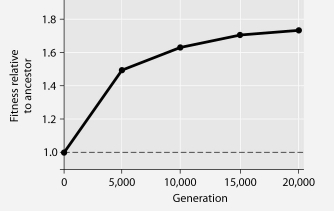The following questions refer to Figure 27.1.
In this eight-year experiment, 12 populations of E. coli, each begun from a single cell, were grown in low-glucose conditions for 20,000 generations. Each culture was introduced to fresh growth medium every 24 hours. Occasionally, samples were removed from the populations, and their fitness in low-glucose conditions was tested against that of members sampled from the ancestral (common ancestor) E. coli population.

Figure 27.1
-If the experimental population of E. coli lacks an F factor or F plasmid, and if bacteriophages are excluded from the bacterial cultures, then which of these is (are) means by which beneficial mutations might be transmitted horizontally to other E. coli cells?
A) via sex pili
B) via transduction
C) via conjugation
D) via transformation
E) Two of the responses above are correct.
Correct Answer:
Verified
Q42: Use the information in the following paragraph
Q43: The data were collected from the heterocysts
Q44: Use the information in the following paragraph
Q45: Use the information in the following paragraph
Q46: During which two times can the recipient
Q48: Use the information in the following paragraph
Q49: Consider the thermoacidophile, Sulfolobus acidocaldarius. Which of
Q50: The following questions refer to Figure 27.1.
In
Q51: Which question, arising from the results depicted
Q52: Figure 27.2 depicts changes to the amount
Unlock this Answer For Free Now!
View this answer and more for free by performing one of the following actions

Scan the QR code to install the App and get 2 free unlocks

Unlock quizzes for free by uploading documents